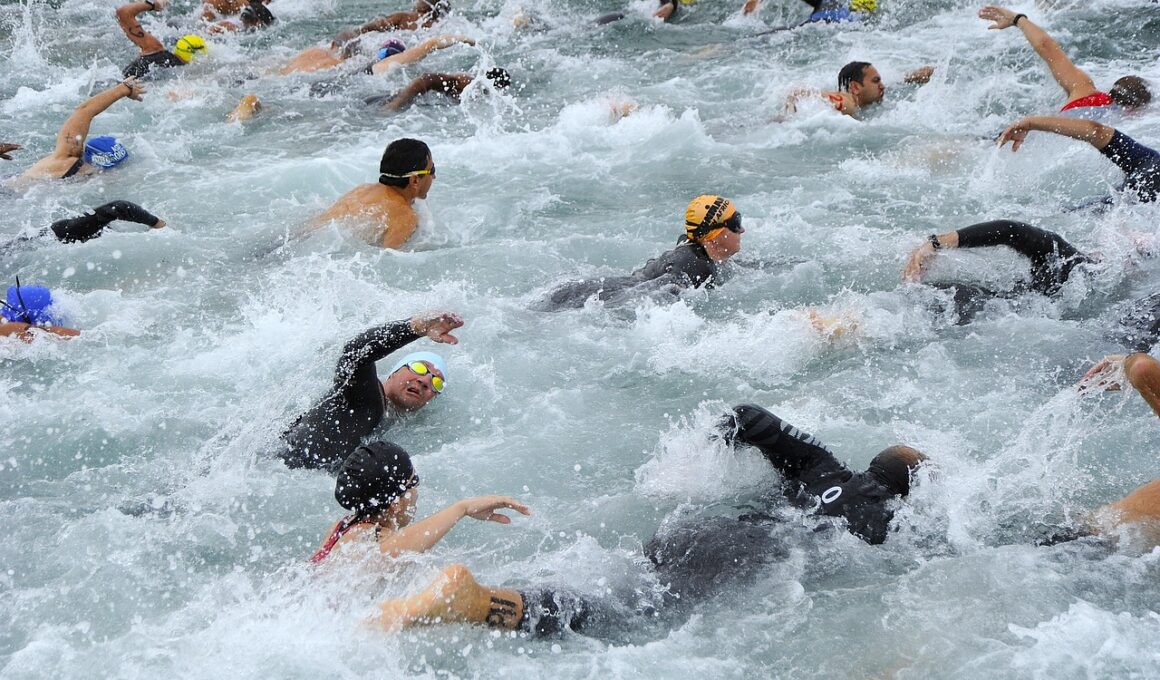Periodization Techniques for Peak Race Performance
In the realm of triathlon training, understanding and applying periodization techniques can dramatically enhance your performance. Periodization is the systematic planning of athletic training aimed at reaching peak performance during specific competition times. This can be particularly beneficial for triathletes who must balance swim, bike, and run training effectively. Effective periodization involves breaking down the training year into distinct phases, allowing for targeted training interventions. These phases include preparation, competition, and recovery. Initially, the focus is placed on building a strong aerobic base, followed by phases focusing on speed and race-specific endurance. Each phase systematically progresses in intensity and volume, optimizing your body’s adaptation to various stressors. For advanced athletes, sport-specific periodization becomes crucial, integrating advanced techniques that address individual strengths and weaknesses. By employing periodization strategies, triathletes can mitigate the risk of burnout and injuries while maximizing performance gains. Periodization also facilitates mental recovery, keeping athletes motivated and engaged throughout their training. Thus, mastering these techniques can play a pivotal role in achieving your race day goals.
While designing a periodized training plan, one must consider several essential components. Firstly, setting clear, specific goals for each training phase is vital. These goals help athletes maintain focus and drive during their training. Additionally, incorporating strength training into the cycle significantly boosts overall performance. Strength training improves muscle efficiency and contributes to injury prevention, which is critical for triathletes, especially during high-volume training phases. Furthermore, establishing a recovery strategy is paramount. This means not only scheduling rest days but also integrating active recovery sessions and proper nutrition throughout the training. A well-structured nutrition plan supports recovery, ensuring the body is primed for the next training session. Moreover, individualizing training plans based on feedback from both physical assessments and subjective feelings is essential. Regularly monitoring progress allows for adjustments that align with how athletes are responding to their training. Employing tools like TrainingPeaks or Garmin can help track metrics, enhancing the plan’s effectiveness. Ultimately, a customized approach to periodization enables advanced triathletes to push their limits while maintaining peak physical and mental health.
Macro and Microcycles: A Closer Look
Periodization comprises various cycles, notably macro and microcycles, each serving distinct purposes in training. The macrocycle typically spans an entire training year, while the microcycle ranges from one week to four weeks, offering shorter-term concentration on specific goals. Structuring your macrocycle involves planning training phases that build upon one another, aligning them with key races or competitions. Usually, the macrocycle contains three significant phases: the prep phase focuses on developing foundational endurance; the build phase is where intensity ramps up, emphasizing race-specific training; and the peak phase gears athletes towards racing. In contrast, microcycles allow for weekly adjustments based on performance and fatigue levels. For instance, athletes may focus on different intensities, such as endurance one week and speed the next, accommodating recovery while pushing for improvements. Within the context of triathlons, understanding the interplay between these cycles is crucial. Effective management ensures that training stress is balanced with recovery, ultimately optimizing adaptation. Athletes are encouraged to regularly assess their performance to identify and adjust training intensity and volume, ensuring that they stay on track as race day approaches.
Integrating different training modalities during each cycle is essential for maximizing performance. Each discipline in triathlon—swimming, cycling, and running—requires unique energy systems and muscle engagement. Therefore, it’s crucial to periodize training across all three disciplines, ensuring adequate focus and preparation for each. Cross-training can complement discipline-specific workouts by building overall athleticism. For example, incorporating strength training during the base phase fosters stability and power for swimming and cycling. Each of these disciplines necessitates specific training sessions characterized by varying efforts, such as long slow distance, tempo training, and interval sessions. Success in triathlon requires mastery of all these components through strategic scheduling. Another strategy that advanced athletes benefit from is incorporating recovery workouts within intense phases. These workouts facilitate active recovery, allowing the body to adapt to higher training loads without inducing fatigue. An example would be a short, easy run or swim after a hard bike session to aid recovery without sacrificing overall volume. Lastly, ensuring nutritional strategies are aligned with the training intensity during each phase can greatly influence performance outcomes on race day.
Monitoring Progress and Making Adjustments
Progress monitoring is an integral part of successful periodization strategies. Athletes are encouraged to keep training logs that include performance metrics, subjective feelings, and external factors such as sleep and nutrition. Utilizing software or apps for logging data can streamline this process, making it simpler to visualize progress over time. It’s essential to analyze this data regularly to identify trends regarding fatigue, recovery, and performance. If an athlete notices prolonged fatigue levels, it may indicate that adjustments in training volume or intensity are necessary. Tools such as heart rate variability (HRV) monitoring can also provide insights into recovery status, allowing for timely adjustments to training loads. Additionally, regular performance testing can help in evaluating fitness progress, affirming which areas have improved and which still need focus. An example would be conducting a time trial in each of the three disciplines. As athletes advance through their training cycles, making data-informed changes becomes crucial to ensure they continue progressing towards their goals. Ultimately, this adaptive approach can be the difference between a strong performance and merely participating in a race.
Recovery plays a pivotal role in periodization techniques, often underestimated yet critical for peak performance. During intensive training phases, athletes may push their limits, resulting in fatigue that could affect the overall training plan. Strategies for optimal recovery include both passive and active protocols. Passive recovery involves adequate sleep, hydration, and nutrition. Athletes must prioritize sleep to allow muscle repair and hormonal balance. Meanwhile, active recovery sessions, like low-intensity swims or yoga, can enhance blood circulation and reduce muscle soreness post-workout. Nutrition is another cornerstone of recovery; athletes should focus on nutrient timing, consuming a mix of carbohydrates and protein post-exercise to replenish glycogen stores and aid muscle repair. Furthermore, incorporating recovery modalities like foam rolling, massage, or ice baths can significantly enhance recovery efficiency. Understanding the body’s signals is essential; ignoring fatigue can lead to overtraining and decreased performance. Utilizing evidence-based recovery strategies can help athletes return to training fresh and energized. In sum, integrating effective recovery into a structured periodization plan is the bedrock of advancing triathletes, preparing them for peak performance on race day.
Conclusion: The Importance of Periodization
In conclusion, mastering periodization techniques is essential for triathletes aiming for optimal performance. Transitioning from a traditional training model to a periodized structure allows for well-structured cycles that prevent burnout and enhance race-day readiness. Athletes benefit significantly from clarity in their training cycles; understanding the purpose and goals of each phase can improve motivation and focus. Comprehensive periodization plans should integrate training goals, recovery strategies, nutrition, and monitoring mechanisms that adapt in real-time to athletes’ needs. This ensures they are always on the path to improvement. Additionally, periodization encourages a balanced approach to training across all disciplines, helping prevent imbalances and injuries. Triathletes may find that by centering their training around periodization, they can optimize their body’s physiological adaptations and ultimately improve race results. As athletes prepare for their next race, investing time and effort into a well-structured periodization plan can spell the difference between mediocrity and record performance. Therefore, for serious triathletes, implementing these strategies isn’t merely beneficial; it’s a necessity for achieving peak race performance.



